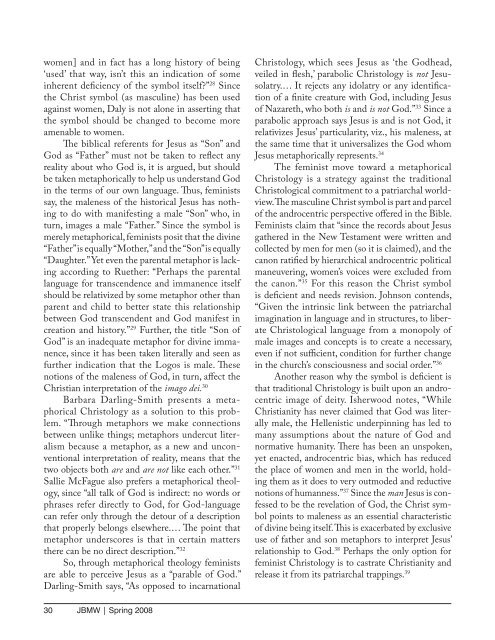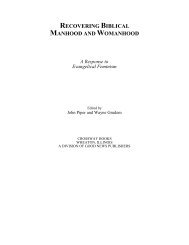Download PDF - The Council on Biblical Manhood and Womanhood
Download PDF - The Council on Biblical Manhood and Womanhood
Download PDF - The Council on Biblical Manhood and Womanhood
Create successful ePaper yourself
Turn your PDF publications into a flip-book with our unique Google optimized e-Paper software.
women] <strong>and</strong> in fact has a l<strong>on</strong>g history of being‘used’ that way, isn’t this an indicati<strong>on</strong> of someinherent deficiency of the symbol itself?” 28 Sincethe Christ symbol (as masculine) has been usedagainst women, Daly is not al<strong>on</strong>e in asserting thatthe symbol should be changed to become moreamenable to women.<str<strong>on</strong>g>The</str<strong>on</strong>g> biblical referents for Jesus as “S<strong>on</strong>” <strong>and</strong>God as “Father” must not be taken to reflect anyreality about who God is, it is argued, but shouldbe taken metaphorically to help us underst<strong>and</strong> Godin the terms of our own language. Thus, feministssay, the maleness of the historical Jesus has nothingto do with manifesting a male “S<strong>on</strong>” who, inturn, images a male “Father.” Since the symbol ismerely metaphorical, feminists posit that the divine“Father” is equally “Mother,” <strong>and</strong> the “S<strong>on</strong>” is equally“Daughter.” Yet even the parental metaphor is lackingaccording to Ruether: “Perhaps the parentallanguage for transcendence <strong>and</strong> immanence itselfshould be relativized by some metaphor other thanparent <strong>and</strong> child to better state this relati<strong>on</strong>shipbetween God transcendent <strong>and</strong> God manifest increati<strong>on</strong> <strong>and</strong> history.” 29 Further, the title “S<strong>on</strong> ofGod” is an inadequate metaphor for divine immanence,since it has been taken literally <strong>and</strong> seen asfurther indicati<strong>on</strong> that the Logos is male. <str<strong>on</strong>g>The</str<strong>on</strong>g>senoti<strong>on</strong>s of the maleness of God, in turn, affect theChristian interpretati<strong>on</strong> of the imago dei. 30Barbara Darling-Smith presents a metaphoricalChristology as a soluti<strong>on</strong> to this problem.“Through metaphors we make c<strong>on</strong>necti<strong>on</strong>sbetween unlike things; metaphors undercut literalismbecause a metaphor, as a new <strong>and</strong> unc<strong>on</strong>venti<strong>on</strong>alinterpretati<strong>on</strong> of reality, means that thetwo objects both are <strong>and</strong> are not like each other.” 31Sallie McFague also prefers a metaphorical theology,since “all talk of God is indirect: no words orphrases refer directly to God, for God-languagecan refer <strong>on</strong>ly through the detour of a descripti<strong>on</strong>that properly bel<strong>on</strong>gs elsewhere.… <str<strong>on</strong>g>The</str<strong>on</strong>g> point thatmetaphor underscores is that in certain mattersthere can be no direct descripti<strong>on</strong>.” 32So, through metaphorical theology feministsare able to perceive Jesus as a “parable of God.”Darling-Smith says, “As opposed to incarnati<strong>on</strong>alChristology, which sees Jesus as ‘the Godhead,veiled in flesh,’ parabolic Christology is not Jesusolatry.…It rejects any idolatry or any identificati<strong>on</strong>of a finite creature with God, including Jesusof Nazareth, who both is <strong>and</strong> is not God.” 33 Since aparabolic approach says Jesus is <strong>and</strong> is not God, itrelativizes Jesus’ particularity, viz., his maleness, atthe same time that it universalizes the God whomJesus metaphorically represents. 34<str<strong>on</strong>g>The</str<strong>on</strong>g> feminist move toward a metaphoricalChristology is a strategy against the traditi<strong>on</strong>alChristological commitment to a patriarchal worldview.<str<strong>on</strong>g>The</str<strong>on</strong>g> masculine Christ symbol is part <strong>and</strong> parcelof the <strong>and</strong>rocentric perspective offered in the Bible.Feminists claim that “since the records about Jesusgathered in the New Testament were written <strong>and</strong>collected by men for men (so it is claimed), <strong>and</strong> thecan<strong>on</strong> ratified by hierarchical <strong>and</strong>rocentric politicalmaneuvering, women’s voices were excluded fromthe can<strong>on</strong>.” 35 For this reas<strong>on</strong> the Christ symbolis deficient <strong>and</strong> needs revisi<strong>on</strong>. Johns<strong>on</strong> c<strong>on</strong>tends,“Given the intrinsic link between the patriarchalimaginati<strong>on</strong> in language <strong>and</strong> in structures, to liberateChristological language from a m<strong>on</strong>opoly ofmale images <strong>and</strong> c<strong>on</strong>cepts is to create a necessary,even if not sufficient, c<strong>on</strong>diti<strong>on</strong> for further changein the church’s c<strong>on</strong>sciousness <strong>and</strong> social order.” 36Another reas<strong>on</strong> why the symbol is deficient isthat traditi<strong>on</strong>al Christology is built up<strong>on</strong> an <strong>and</strong>rocentricimage of deity. Isherwood notes, “WhileChristianity has never claimed that God was literallymale, the Hellenistic underpinning has led tomany assumpti<strong>on</strong>s about the nature of God <strong>and</strong>normative humanity. <str<strong>on</strong>g>The</str<strong>on</strong>g>re has been an unspoken,yet enacted, <strong>and</strong>rocentric bias, which has reducedthe place of women <strong>and</strong> men in the world, holdingthem as it does to very outmoded <strong>and</strong> reductivenoti<strong>on</strong>s of humanness.” 37 Since the man Jesus is c<strong>on</strong>fessedto be the revelati<strong>on</strong> of God, the Christ symbolpoints to maleness as an essential characteristicof divine being itself. This is exacerbated by exclusiveuse of father <strong>and</strong> s<strong>on</strong> metaphors to interpret Jesus’relati<strong>on</strong>ship to God. 38 Perhaps the <strong>on</strong>ly opti<strong>on</strong> forfeminist Christology is to castrate Christianity <strong>and</strong>release it from its patriarchal trappings. 3930 JBMW | Spring 2008




